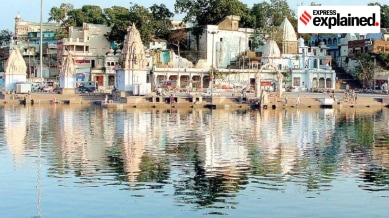What is MP’s Simhastha Land Pooling Policy and why was it revoked
This week, the Madhya Pradesh government revoked the proposed land pooling scheme in Ujjain following farmer pushback. We explain everything about the scheme and its aftermath.

Earlier this week, the Madhya Pradesh government revoked the proposed land pooling scheme in Ujjain, aimed at permanently acquiring thousands of hectares of land to build infrastructure for the Simhastha Kumbh Mela, 2028.
A major land acquisition initiative by the Madhya Pradesh government, the Simhastha land pooling policy was withdrawn after widespread farmer protests and political backlash. Here’s what it was.
Simhastha Land Pooling Policy – key provisions
The policy aimed to pool government and private land so the government could build permanent roads, utilities, sanitation, and large-scale facilities for the massive influx of devotees during the decennial Simhastha mela.
The policy targeted pooling between 2,376 and 3,360 hectares of land in all, of which approximately 850 hectares was government land and the rest private agricultural land from about 1,800 farmers. The goal was to convert this area into a permanent “mega city” for Simhastha festivities.
Farmers who participated in land pooling would retain ownership of 50 percent of their land in a consolidated, developed form with access to wide roads and infrastructure.
The other 50 percent would be used for public infrastructure development, and the government would compensate farmers at market rates for this portion.
For farmers who did not consent to pooling, an alternative scheme was proposed for land acquisition with double compensation. Until construction started, farmers could continue cultivating their land.
Why was the policy revoked
The biggest reason for the scheme’s failure was steadfast opposition led by farmer groups such as the Rashtriya Swayamsevak Sangh-affiliated Bharatiya Kisan Sangh.
Farmers’ organisations saw the policy as an attempt to grab land to disproportionately benefit the government and developers. Specific objections included the loss of permanent ownership of ancestral land and perceived unfairness in the compensation and redistribution of land.
Escalating protests, including a threatened indefinite “derao Andolan” or sit-in agitation, created immense political pressure. With protests intensifying, the government is believed to have capitulated on all fronts to avoid broader unrest before the start of the Simhastha preparations.
The aftermath – stalled infrastructure projects
Even though the local administration is still working out the fine print of how to build the temporary city, the revocation threatens to put several projects on hold.
This includes plans for 60-, 80-, and 200-feet roads across the Simhastha area for crowd management, underground water pipelines, electricity poles, and modern sewage lines. Meanwhile, infrastructure projects for hospitals, schools, parking facilities, and public parks in the Simhastha zone are cancelled.
Instead, like in past Simhastha festivals, authorities will now work on infrastructure requiring voluntary and temporary land use — tents, sheds, temporary roads, and event-focused facilities.
“The priority is to develop temporary infrastructure which can accommodate the huge crowds,” one government official said. “Our team will study the UP Maha Kumbh infra projects to make this project a success.”
How will crowd management be ensured without permanent land acquisition
Like with this year’s Mahakumbh mela at Prayagraj, the local administration is expected to leverage temporary but robust practices and technology.
These include sturdy moveable barriers, fencing, ropes, and dividers to “create designated lanes, control crowd flow, and prevent surge points”.
“The main aim to prevent a stampede. We are also working towards use of real-time monitoring tools such as CCTV cameras, drones, crowd density sensors, and AI-based analytics to oversee large groups, identify congestion points,” the official said.